About 75 people packed into the St. Johns Community Center on a rainy Monday night because they want the streets in front of their homes, schools and businesses to be safer and more humane.
The event, hosted by the St. Johns Neighborhood Association’s Safety and Livability Team, was scheduled before the death of a bicycle rider on the St. Johns Bridge late last month; but that tragedy has given even greater urgency to the concerns expressed last night.
Like many areas of Portland, St. Johns residents are fed-up with their streets being dominated by people who drive too fast and cut-through their neighborhoods to avoid congestion. Another issue on the minds of many last night was how their part of the city is hemmed in by large arterial streets managed by the Oregon Department of Transportation to prioritize freight traffic at the expense of everything else.
“Trucks drive fast past homes and crosswalks,” someone scrawled on a piece of paper that was turned in after the meeting. “And the road is too small for them… Residents don’t open their windows because of the fumes!”
Among the attendees were Oregon House Speaker Tina Kotek (a north Portland resident), St. Johns Neighborhood Association Safety and Livability Team Chair Travis Parker, Oregon Department of Transportation Metro West Area Manager Ana Jovanovic, and Portland Bureau of Transportation Active Transportation and Safety Division Manager Margi Bradway. All but the ODOT staffer gave brief presentations and took questions from the audience. After that, people were asked to write down issues of concern and then discuss them with others in a group exercise. The meeting ended after a representative from each group stood up and shared a summary of their discussion.
Here’s how the presentations went…

PBOT’s Bradway focused on the city’s Vision Zero efforts. At the outset of her talk, she tried to connect with the audience by sharing how much city staff cares about traffic safety. “I get choked up talking about this,” she said, “I want you to know there is not a dry eye on my Safe Routes to School staff when a kid gets hit on the way to school.” Bradway was referring to Bradley Fortner-Trujillo, a 15-year old who was nearly killed back in August by someone driving a truck as he attempted to cross Columbia Blvd near a middle school.
“We’re trying to tackle this issue, but we’re facing an uphill battle. The numbers are going in the wrong direction.”
— Margi Bradway, PBOT
Bradway added that this year has been “particularly tough” for PBOT morale because we’ve had 37 traffic fatalities, “the highest any of us can remember.” “We’re trying to tackle this issue, but we’re facing an uphill battle,” she said. “The numbers are going in the wrong direction.”
But there’s also good news on reducing speeds and Safe Routes to School.
Bradway reported that the city’s new photo radar camera program is “going really well.” The cameras are generating fewer tickets than expected which means people are slowing down. PBOT plans to roll out a new set of cameras every six months. Also on the speeding front, ODOT has officially granted PBOT permission to streamline the onerous process of requesting lower speed limits (something the state controls, even on city-owned roads). We reported on this effort in August and Bradway said they are moving forward with a pilot process with ODOT’s support. PBOT will test their new speed limit reduction request methodology on non-ODOT arterials.
Advertisement
Bradway also shared that PBOT is prepping a $13 million citywide investment in the Safe Routes to Schools program. Thanks to an $8 million infusion from the gas tax which PBOT leveraged into $5 million additional dollars, Bradway called it the city’s “biggest Safe Routes to School investment ever.”
A hopeful presentation slammed back into reality once the audience had a chance to respond. When someone asked about reducing speeds on Columbia Blvd where that 15-year-old boy was hit, Bradway acknowledged that ODOT won’t let them reduce the speed limit because freight has the priority. Bradway said that figuring out how “we can have safety and mobility coexist” is a central challenge of Vision Zero. “Those are tough conversations,” she said.
Another audience member stood up to express his anger and fear that the city “allows” people to park large motor vehicles too close to corners, which makes it hard to walk across the street in front of his house. “I’m playing ‘Frogger’ every day!” he said to a loud round of cheers. “I have to dash across the street because I can’t see around them. As soon as you step out there’s a car coming at you at 40 miles per hour!”
Bradway thanked the man for bringing up the issue, but didn’t have a very satisfying answer. “Like the mobility [freight] and safety conversation,” she said. “We’re having this tradeoff between parking and safety. We’re having those conversations internally and working on our policies.”
“To say that ODOT won’t do anything about Columbia because they want to prioritize freight is insane. People are dying.”
— Travis Parker, St. Johns Neighborhood Association
The neighborhood perspective continued when Parker shared some of his work. Parker is a dedicated volunteer who has made safer streets a personal crusade. Following that tragic collision back in August, Parker was “shocked” to learn there are 200 households separated from the rest of St. Johns because they live north of Columbia Blvd — a high-speed arterial that’s a designated freight route and has very few safe crossings. He shared images of the Midway footbridge over Columbia near George Middle School and explained most people don’t use it because it’s not maintained and isn’t easy to use. “This is something that needs to be fixed,” he said. “Immediately.”
Parker was visibly frustrated with ODOT’s defense of freight traffic on Columbia. “They’re putting freight first, which isn’t putting drivers in their cars or pedestrians or cyclists first… To say that ODOT won’t do anything about Columbia because they want to prioritize freight is insane. People are dying. If you don’t change that, we’re going to have another high school kid get hit.”
Parker mentioned the St. Johns Bridge briefly, saying his preference is to calm traffic and lower speeds. (Parker and others are currently meeting and strategizing about the St. Johns Bridge. We’ll cover those efforts in a future post.)
After Parker it was Oregon House Speaker Tina Kotek’s turn to address the crowd. Coming right after Parker’s comments, Kotek reinforced the dominance of freight from the state’s perspective: “When you’re on a freight route it’s very difficult to change that… We will continue to have freight on our roads,” she said. Kotek, who lives in the nearby Kenton neighborhood, alluded to the upcoming transportation funding package that will be proposed in the 2017 legislative session. She said part of any new revenue from that package will build infrastructure for safer biking and walking. “As St. Johns continues to grow, we have to continue to do more to have safety and also have freight movement. I will do what I can to advocate ODOT.”
Kotek also made a few comments about switching ownership of Portland’s “orphan highways” away from ODOT and to PBOT (a.k.a. jurisdictional transfer). Kotek said the state would like to do that but it’s a question of financing. PBOT doesn’t want the roads unless they’re in good condition so ODOT has to pour money into them before any transfer can take place. “We were successful with Sandy [a street that used to be owned by ODOT but is not under PBOT control],” Kotek said optimistically, “and we’d like to do that on Lombard as well.”
After her remarks Kotek listened and took notes as everyone participated in a group exercise. In small circles, people got to know their neighbors and discussed their top traffic safety concerns. Not suprisingly speeding, cut-through traffic, and freight were mentioned by several groups. Related to freight, many people in St. Johns are concerned about how diesel engines lead to dirty air. Another issue that was mentioned is the lack of a safe cycling connection between St. Johns and downtown Portland. Also mentioned in the groups: the growing impact of Waze on cut-through traffic, the need for light rail to St. Johns, a new freight-only bridge, and the feeling that the sharrows and sidewalk on the St. Johns Bridge are “absolutely deadly.”
At the end of the meeting, longtime resident and activist Shamus Lynsky said his growing neighborhood has been left without enough mobility choices. “We’re not doing enough to relieve the congestion because we don’t have viable transit or active transportation options, so people are forced into their cars.”
— Jonathan Maus, (503) 706-8804 – jonathan@bikeportland.org
BikePortland is supported by the community (that means you!). Please become a subscriber or make a donation today.



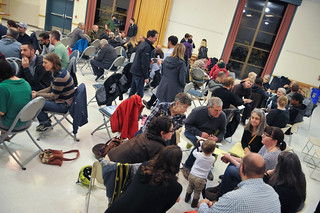
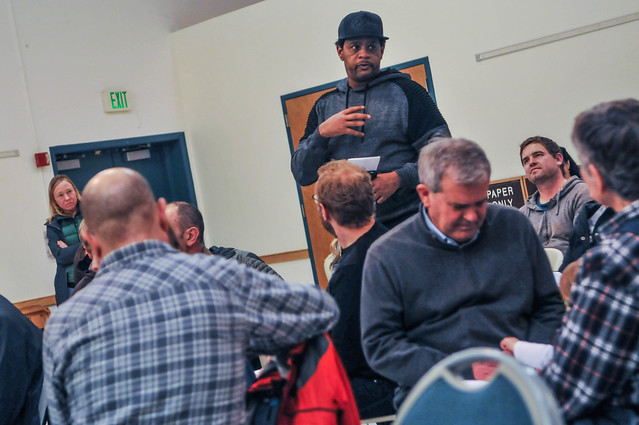
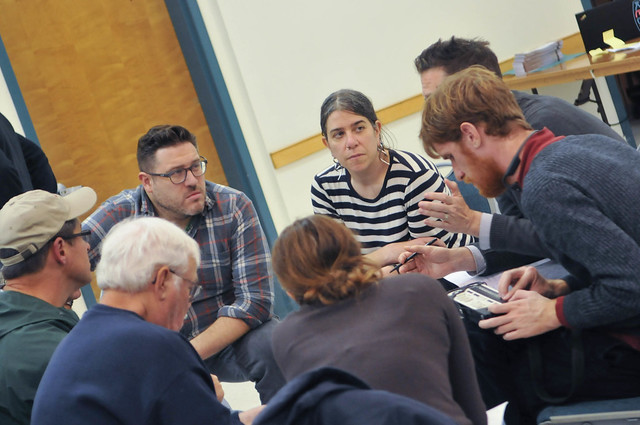
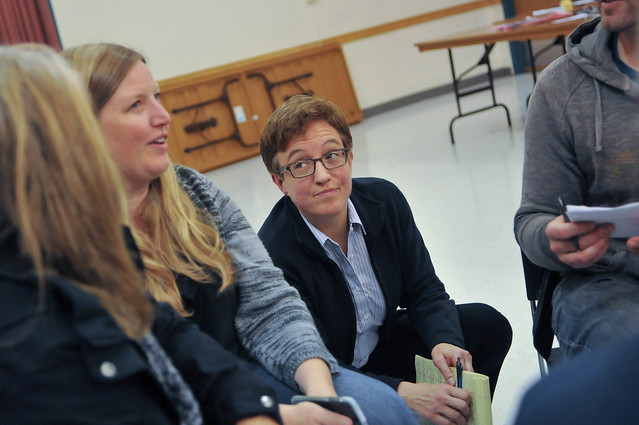

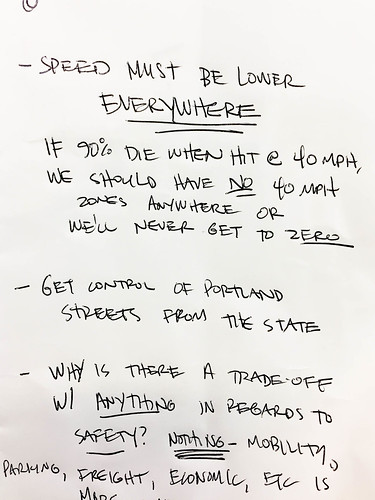
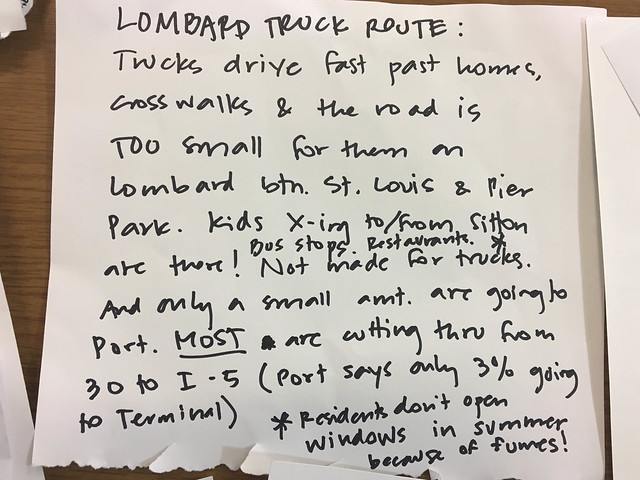
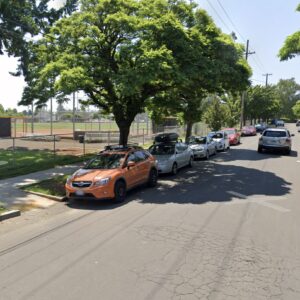


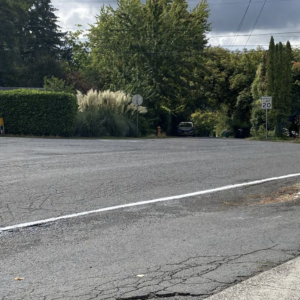
Thanks for reading.
BikePortland has served this community with independent community journalism since 2005. We rely on subscriptions from readers like you to survive. Your financial support is vital in keeping this valuable resource alive and well.
Please subscribe today to strengthen and expand our work.
It is frustrating to read Bradway complain about these difficult trade-offs between freight and safety- I thought that was explicit and primary point of adopting Vision Zero! VZ is supposed to provide bureaucrats and decision-makers a clear priority when discussing these trade-offs. This article leaves me feeling very cynical about Portland’s VZ prospects
Max,
While the roads are for more than moving people, you also have to recognize that there are much more dangerous corridors in Portland than N Columbia.
What frequent parade of semitrucks uses SE Division from the farmland to the Willamette River?
I get that , but what is your point? My understanding is that VZ is meant to prioritize safety over all other concerns (not erase those concerns). So when PBOT is faced with a tradeoff like slower speeds for increased safety vs higher speeds for faster freight movement the decision would be weighted for safety.
Less of a defense and more of point: PBOT has done a great deal to calm freight and improve pedestrian safety on Lombard, Ivanhoe, St. Louis, and Fessenden through STJ (not perfect). ODOT has done nothing but prioritize freight on STJ Bridge and Columbia Blvd through residential STJ. ODOT won’t even come to the table. PBOT will at least show-up and discuss.
Too, I have some curious emails from the Port of Portland regarding prioritizing freight — some reaching justifications.
Is N Columbia counted as less dangerous because less peds/bikes utilize it and there are less incidents?
The objective of Vision Zero is to spend lots of staff time having meetings to talk about things related to safety and to prepare reports explaining the progress we’re expecting to make. Remember we have a task force and a new logo!
And a steering committee which will prepare a preliminary white paper, which will undergo six months of review by focus groups picked by a community involvement group.
I think we should bring an environmental agency into the mix here. Something about turtles?
Please fill out and return the following community survey
1a.
[ ] I like turtles
[ ] I do not like turtles
I like turtles.
But…is this survey designed to prevent me from riding my bike in the woods near your house?
The shift of freight from rail to trucks was similar to the shift from streetcars to buses and automobiles earlier in the last century. It was not done by the will of the people, but scheming on the part of corporations.They should not be to similar that we have had enough of that and want our cities back.
What impact has the loss of shipping from the Port had on truck traffic?
It seemed to have a dramatic effect on the amount of freight traffic here in SJ’s immediately after the port lost the big container companies. Traffic gets more intense every morning here.
“Why is there a trade-off w/ anything in regards to safety?”
this is really the only topic…
why is the ability to move motor vehicles more quickly over a shorter distance more important than the safety of the city’s residents?
it isn’t…
and anybody in the game that says otherwise should be kicked out of the game…
Yes. Jonathan’s image cuts off my final point (that was my sheet):
“Why is my convenience more important than your safety?”
“…Another issue on the minds of many last night was how their part of the city is hemmed in by large arterial streets managed by the Oregon Department of Transportation …” bikeportland
“…why is the ability to move motor vehicles more quickly over a shorter distance more important than the safety of the city’s residents? …” spiffy
I doubt that anyone at that meeting, or reading here, considers that fast motor vehicle travel is a higher priority than safe use of the road by residents of St Johns, greater Portland, or visitors to it. Still, there are travel needs of both citizen and business…which is jobs…in need of being reasonably met, so some compromise will likely be an answer for at least the short term.
The arterial and neighborhood streets that freight typically uses for routing, seems to me, may be very important to look at: what’s the posted and actual speeds traveled on those streets…what’s the volume of motor vehicle traffic on those streets?
That concentrated effort is being made by ODOT and PBOT together to examine street posted speed limits and reduce them where feasible, is an encouraging step towards greater safety and functionality of city streets, particularly through and on the perimeter of neighborhoods.
Slower mph likely would add some time to freight travel, and time is money…but through this relatively small neighborhood, resulting slower travel time may not be so great as to be unfeasible.
Living out in Central Beaverton, very near to the big east west thoroughfares, I can thoroughly relate to the downside of huge numbers of motor vehicles on those road, including big, smelly exhaust trucks often traveling at mph speeds that can overwhelm practical and comfortable use on foot and bike, of the streets, sidewalks and bike lanes.
When we moved here in ’04 the 17 connected SJ’s to downtown and the 16 wrapped itself all the way around Fessenden. Now the 17 is gone and the 16 is unreliable. When a driver misses a shift TriMet pulls a driver from an undesirable line going out to a less advantaged part of town; often it’s the 16.
Unfortunately Kotek’s goal is to pour billions into widening the freeways that divide Portland. She completely turned a deaf ear to safety concerns around the CRC and her plan for the CRC would have created massive increases in cut through traffic on neighborhood streets as people attempted to avoid the toll by using the 205 instead of the I-5. We aren’t going to get any help from her on making Portland Streets safer IMHO.
The CRC would be terrible for St. Johns and N Portland in general. The southbound bottleneck would move from the bridge to I-5 south of Columbia Blvd, and trucks/commuters would increasingly use surface streets and the St. Johns bridge to get into downtown. If that bridge does ever get replaced, we better have demand-based tolling to control the flow.
Thanks for posting this. For those new to the area, feel free to research the proposed Columbia River Crossing (And it’s induced demand.) Tina was all in with the developers and all against the will of the people. She wanted to expand the highway all of the way from North Portland through Vancouver and further north, adding more lanes and off ramps/ onramps, dividing communities further.
As our elected officials seem to always get reelected, I hope those at the meeting (Sorry I couldn’t make it) reminded her that we need officials on our side, and not the side of the automobile industry/ oil industry/ concrete and rebar/ etc.
Not to be overly tribal (just normally tribal), but does anyone in the legislature use anything other than a car as his or her primary means of transportation?
If our legislators were highly intelligent and empathetic people with good sound knowledge bases, this wouldn’t be relevant, but they’re not. I suspect they view any slowing of motor vehicles for safety as a huge imposition, similar to what many motorists express when they have to slow down a bit for someone on a bike or in a crosswalk.
Washington County commissioner Dick Shouten often rides a bike.
Any motorist cited for failure to stop for a pedestrian during one of a crosswalk enforcement action should be required, as a condition of his/her penalty, be sentenced to be a pedestrian decoy at a subsequent crosswalk enforcement action. Maybe the same should be a requirement for serving in the legislature. That would provide these people with a flavor for what it’s like to actually be a pedestrian.
Some have suggested expanding WES to Salem to help take traffic off I-5. Many Portland-based members of the state legislature commute to the State Capitol by car because there’s no viable alternatives. Yeah, there’s the Amtrak Cascades train, but the schedule doesn’t fit in with legislators who often have early morning committee meetings before (and sometimes after) the floor sesssions. The Seattle/Portland/Eugene corridor has been on the federal list for high speed rail service for several years now with very little movement on the subject. Would Trump support that idea? Nobody knows.
ORS 811.550 (17)
North Columbia in that area his way over capacity. It could have a median to keep opposing traffic safe and separate, and turn the outside into a protected bike lane, and still serve the current amount of traffic on the street.
Perhaps ODOT’s whining about freight would be easier to swallow if they didn’t have two parallel streets, often less than a mile apart – in Columbia and Lombard – that are ‘untouchable’ because we need to kill as many people as necessary for the benefit of freight. How about if you drop the designation on Lombard, and do what you need to do to make Columbia THE viable freight option.
Your iPhone wasn’t dropped in your lap by a stork.
Your statement is correct, but how is it relevant to the discussion at hand?
Indeed. Now that we have that established, let’s have a mature and intelligent conversation about transportation safety.
What about the third major option that parallels these two roads and is often less than a mile away: I’ll give you a hint, it’s a major freight route, fully within Portland, 5 lanes of 45 mph posted speed, it connects I-5 directly with Industrial areas, the Port, and St John’s. N. Marine Drive. So, there are two road freight options that basically serve the same purpose: Columbia and Marine.
I ride Lombard regularly. I don’t understand why folks are kvetching about freight there. It’s a busy street that’s not great to ride on for a bunch of reasons, but freight is not one of those reasons.
Columbia, on the other hand is freight heavy and very cycle unfriendly. But given what it connects, I wonder how many more people would ride it even if it were nice.
Do you ride on N. Lombard between St. Louis and Reno streets? City has in the past couple of years installed “bike lanes” on the gutters of this street. There is a big dog-leg on this road at N. St John’s street, and it is a highly dangerous place to be on your bike when the big rigs are flowing through there, just starting to accelerate or decelerate to/from about 40 mph, depending on their direction of travel.
Yes, “The city ‘allows’ people to park large motor vehicles too close to corners — which makes it hard to walk across the street in front of his house,” but ORS 811.550 (17) and (18) don’t allow that.
“Another audience member stood up to express his anger and fear that the city “allows” people to park large motor vehicles too close to corners, which makes it hard to walk across the street in front of his house.”
I can’t remember from whom I heard this (Terry D-M, maybe it was you?) – guidance or regulations or whatever (state, city? can’t remember) state that cars should not be parked within 20 feet of an intersection on residential streets, and PBOT does nothing to enforce this (or I have it wrong).
Anyone know more about this?
That’s correct, it’s illegal to park within 20 feet of a crosswalk at an intersection, per http://www.oregonlaws.org/ors/811.550
We have illegally painted parking spots all over town.
I’ve seen books of official blank parking tickets available on line for puchase. Maybe a DIY parking enforcement opportunity. It would not be emmediatly obvious that the parking ticket was not city issued, and may serve to educate some who have been parking next to crosswalks for years and think it’s okay.
Leah Treat said enforcement of this law was “complaint driven.”
Nonsense. PBOT’s policy has long been to favor parking availability over the safety of vulnerable traffic trying to cross roads.
I know. It’s insulting.
It’s not just safety of vulnerable traffic — it’s everybody’s safety because no one can see anyone. Peds and cyclists are vulnerable to everyone, drivers are vulnerable to other drivers. This is truly a big deal that permeates the entire city and if this type of illegal parking were dramatically reduced, it would improve safety for everyone.
Aside from preventing people from seeing what’s happening on cross streets, vehicles often prevent road users from seeing critical information (like Stop signs)
BTW, if a sign is blocked from view and it causes an accident, I would imagine that would be relevant when determining how to divvy up liability.
Thank you Kyle, for not suggesting that we need to ride differently to account for illegal parking spaces, and placing the blame where it rightfully belongs.
As a side note:
Dear Family, if I’m ever killed in Portland and poor sight lines are a factor in the crash because someone is parked in an illegally painted parking space, please sue the bejeezus out of the city.
In that other thread, people asked what types of things I had in mind when I said we have bigger fish to fry.
This qualifies. It would make a significant difference in safety throughout the city, it’s feasible, and the cost of implementation could be covered by fines issued to lawbreakers.
Even if you’re on a through road, the only way to safely navigate intersections where visibility is obscured by parked vehicles is often at a walking pace. I slow down even if I’m running (i.e. on foot) in the street, but I know that many people don’t.
I believe this is an issue that many motorists would support, even though it reduces parking.
“complaint driven” = “we’ll do something once the cacaphony of upset people gets too large for us to ignore. and then we’ll only do it grudgingly.”
Yeah, that’s pretty much what I heard when she said that in response to my direct question. I could spend all day calling in illegally parked vehicles without ever leaving my neighborhood.
Freight can’t move at 20mph instead of 40? For 10 miles, that would only add 15 minutes. Since we don’t have any money to spend, let’s just do that.
Before you lower the speed limit on the St. Johns Bridge, how about trying to enforce the current speed limit? Most cars are going way over it. A photo radar camera on the bridge would fix that, make money for the city and save lives.
After the meeting, I drove across the St. John’s bridge going 30 mph. It was dark and rainy, but neither conditions nor posted speed limit deterred a tri-met administrative vehicle (small van – license plate E261749) passing me going approx 45 mph. As usual in these situations, I caught up to them at the red light at end of bridge.
I am regularly passed by police & city vehicles when I drive the speed limit.
What is the structure of “freight” anyway?
Is it a huge cluster of companies that invest heavily in lobbying and are too difficult for local officials to regulate? Are there centralized players? Is there any coordination to limit redundancy, waste or overuse, or is it all driven by the market- meaning that small profit increases are being highly overvalued against the cost to society.
I have never heard any details from any elected officials including ODOT/ PBOT.
Who is in charge of telling freight to get their * together?
You have to consider many Oregon farmers trying to get their feed, straw, and christmas trees to Asia where they can get a few more dollars for a bale of straw than they can selling it locally. I imagine that this bucolic ideal of a “family-farm based agricultural export economy” (in other words, selling Oregon’s public water resources abroad) is how ODOT justifies keeping the dry box shipping containers moving through the neighborhoods of Portland on old, polluting diesel rigs. But, I suspect the corporate ag interests have moved into this arena, and also that not too many of those dry box containers are really hauling Oregon product, rather just getting shuffled around between rail yards and ports in the logistics systems by international rail and shipping companies.
Yes, Bald One. I really appreciate your posts and perspective on this matter as you’ve demonstrated a deep knowledge of (for example) the machinations of UPRR. I know they bragged about their Portland to Chicago traffic doubling, a couple years back. I also puzzle over their redesignation of Brooklyn Yard and their moving of major operations there, which seemed beyond effortless==seemingly overnight. Was it mainly because the redesignation rendered Eastmoreland’s longstanding lawsuit against them moot (on a technicality, as I read somewhere)? Where were the public hearings on that one? It seemed to happen with no input from those most affected, and with disastrous consequences for neighbors. I’ll never fully understand why they’d forgo a train yard (Albina) with great freeway access to one (Brooklyn) surrounded by neighborhoods, necessitating huge inconvenience in shipping and a literal, overnight clobbering of neighborhood streets by diesel-spewing semis. We desperately need to be rescued from this traffic and the horrible quality of life its creating on SE 26th.
Any more illumination, much appreciated. Thanks, R.
UPRR Brooklyn Yard law suit was over noise from train coupling. They basically fixed that issue from rubberizing the couplers on the train cars, which reduced the noise, and also to some extent upgrading some diesel locomotive engines. But, also, the operations are different now than they were historically, when individual box car and train car coupling was more of a necessity for stringing together trains for cross-country travel. Now, these trains predominantly carry flatbed traincars loaded with intermodal box containers that are placed on top of the rail car. These box containers flow into the yard on trucks. So, the yard operates as a destination way point for dry box shipping containers that are loaded on/off trains from trucks at this location. In general, these item flow empty back west to Portland from all over the USA, and flow full back east to the USA from Asian ports. Also, there is some service to regional users: people (farmers, wholesale distributors, manufacturers) truck these containers from within 600 miles to this point to get them back into the international intermodal freight system.
Thanks for your input. Its fascinating stuff that has a big impact on people’s lives. I don’t expect you to answer these questions, but I do wonder:
Who keeps track of freight? How many warehouses or distribution sites? How is it zoned? How many trucking companies? Are they generally cooperative to consolidate resources or are they competitive and redundant?
Are they pushing back on reducing speed limits or traffic calming or is it a knee jerk response from ODOT? Do their lobbyists just keep a general party line or are they actually looking at each issue intelligently?
Great questions. I wish there was more transparency from the RR industry about how these things move, and I wish there was more local control of these movements – to address some of the issues you mentioned: redundancy, efficiency, pollution, road damage, noise, economic impact and justifications, local jobs, local economic benefit, etc. I think the past relationships of government with freight have been one of “freight needs…” and “ODOT/PBOT provides….” Historically, Portland (our location on rail lines, shipping lines, rivers) was an incredibly important cross-road and hub for movement of goods throughout the world, and it brought many jobs and local economic benefit. But, more recently, as the industry changed, and China, Inc. has grown to dominate world manufacturing, and shipping companies move jobs and money out of local economies like Portland and send the profits far away, we should re-evaluate our local infrastructures and red-carpet services to this industry.
IMHO, we do not get the local benefit and jobs from this industry relative to the impact it has on our community in the way that we used to get these benefits (longshore jobs, dock jobs). Sure, there are some truck driving jobs, but these cannot be controlled or regulated since the operators are coming from the metro area outside of Portland and tend to work for small businesses and independently, so there is little corporate backing or accountability for things like behavior, road damage, and pollution.
City of Portland tends to use the words “freight” with respect to “bicycles” in a very vague and general way – typically dressing up “freight” as some grouping of small trucks servicing small local business down in the central eastside (think a brewery, restaurant, woodshop, or distillery). But, the freight lobby is hiding behind these stated local interests of some small manufacturers and businesses to have an undue influence on streets use policy that allow these international guys to profit and benefit. We see this in the Central Eastside. In St John’s, it’s a little different. After they closed the Port shipping operations over the last few years, the container movements have switched from Terminal 6 on Marine drive, to the NW Container Services yard on N. Lombard (at the junction with N. Columbia by Chimney Park). NWCS have a rail link there where they are able to send these empty containers up to Seattle/Tacoma to get loaded onto ships for Asia. Due to the fact that most rail lines are permanent and cannot move, there are also some issues with rail lines not meeting up in the same yard, and UPRR and BNSF having to use trucks within the city of Portland to ferry box containers between different train yards to get them onto different train lines and into different locations out of state. There are still many other freight uses of the STJohn’s bridge – many bulk goods are brought into the terminals 4, 5 along the willamette and truckers are picking up fertilizer, chemicals, and other commodities and driving them through STJ. The Port of Portland is best and most frequently used for bulk goods (grains, autos) that can get directly loaded from ship to train. It’s the dry shipping container industry that has the rail yards that are not in the Port, and so need to drive their trucks all through the city.
Thanks. This is a lot to chew on. Sounds like a free for all. It would be great if PBOT looked at this proactively to identify ways to decrease conflicts between freight and people’s lives. I am guessing that the different companies don’t pay much attention to the whole system.
Jonathan, as for the comment:
“Bradway reported that the city’s new photo radar camera program is ‘going really well.’ The cameras are generating fewer tickets than expected which means people are slowing down.”
Did you infer that less tickets = slower driver speeds? Or did Broadway state this?
Because “less tickets issued” could also be due to any or all of the following:
– high speed threshold setting before a camera takes an image (what is the threshold that PBoT uses? – I did not see it on PBOTs FAQ page);
– warnings issued for _____instead (policy);
– image taken but ticket not issued due to driver is not identifiable/ plate obscured etc.; and
– other…
https://www.portlandoregon.gov/transportation/article/576452
[PS. I strongly support automated speed and red light camera use.]
The tickets should fire for 1-2 mph over the speed limit, not the +9 mph that encourages speeding. BTW, Beav/Hillsdale is far safer (and slower) than before the installation of cameras.
Yes – there is a good correlation between their effectiveness and the lower “buffer” above the posted speed limit. When I was working on pedestrian fatalities prevention in Abu Dhabi…the UAE had quite a good network of speed cameras but the [initial] policy was to set a very high buffer {20 to 30 kph] before they would trigger…thus undermining their effectiveness except for managing extreme speeding.
Perhaps in Portland: there should be a two tier approach:
1) recorded driver speeds from >2mph to 5mph = warning [1 warning per location]; and
2) all others >5 mph then a ticket…
[Some judges may still use discretion to reduce a fine if the driver’s speedometer was found out of calibration and repaired. Unless the prevalence of GPS has reduced this “out” for drivers.]
Additionally, I have often thought it would help with city/ Police PR problems with this technology if a city were to get neighbourhood association/ business association vote for establishing “zero tolerance” speed enforcement zones. These enforcement signs could be posted similar to how work zone (fines double) are done.
Just quibbling a bit on your suggestion, but I’d go simply for up to 5 mph over being the latitude given, and from 6 mph and over, you get a citation. Sending people warnings for going 2 mph over, sounds too exacting, and sounds also like a lot of paperwork, phone messages or whatever.
Maybe it’s just me, but I find I have little difficulty keeping the vehicle speed no more than 5 mph over…but keeping so close a watch on the speedometer to keep the vehicle from traveling no more than 2, 3, or 4 mph, may draw too much attention away from the road ahead and who is using it.
I think 10% ought to be enough. That’s up to 27.5mph in a 25 (which I think still think is too fast, BTW), but at least it further reduces speeds in a very critical area: 25mph zones. The frequency of pedestrians being hit is the highest in 25mph zones, and the percentage of children being hit is much higher as well, because these are the roads that they frequently walk, bike and play in.
That’s fine for you to think so, but I don’t think obliging people that drive, to keep their speedometer no more than 2.5 miles over the posted speed limit, is practical for people driving, and in the comment you responded to, I believe I stated the reason why I think so.We should be wanting the attention of people driving to be on the road, who is using it and where they are…rather than on the speedometer for too much of time, to keep from getting a citation.
In 25 mph posted zone, while it’s certainly likely that there are people driving excessively high mph speeds, and collisions are arising from this, 5 mph over, or top speed of 30 mph, doesn’t seem likely to me to be the level of additional mph speed that is contributing significantly to the occurrence of collisions.
There’s got to be a cut off point somewhere though. That’s why I thought about and suggested 6 mph as the cut off point, even though at that mph speed over posted, is also likely not to be a point at which collisions are particularly occurring. With no cut off point though, some people will just decide they can safely drive at even faster and faster speeds, creating ever more dangerous situations. I’d guess the collisions are occurring at 10 mph and faster, over posted.
Asking for basic competence is asking too much? If you can’t hold the speed steady, slow down. Wow.
I think an obligation to keep motor vehicle speed no more than a maximum of 2.5 mph over posted speed limit at threat of citation, far exceeds basic competence, and would be an unreasonable, and likely unsafe obligation to make of people driving.
It seems to me that outside of perhaps a small number of people in bike advocacy circles, it’s doubtful that most people would consider 5 mph over posted speed limit to be excessive, whether in 60 mph zone, or a 20 mph zone, or would consider that a citation for going faster than 2.5 mph over the posted, was reasonable.
For anyone serious about it, putting together some kind of formal proposal for the 2.5 mph over posted, citation break point, might be a worthwhile way for to find out with more certainty, just how the public would respond to such an idea.
Public vote, again? Let’s imagine what the city would look like if roads were determined by popular vote: One massive highway with only my car on it, built for free. Hmmm.
25mph in a 20mph zone is a 25% cushion. Way too much. I have zero trouble sticking to the speed limit….do you personally find this challenging?
Regarding speedometer error, if enough (not necessarily all) camera enforcement zones utilized the “Your Speed Is” signs at the entry point of the zone, it could help drivers mentally calibrate their speedometers. My own speedo registers about 4 mph faster than I’m actually going (at least at speeds under 40-ish), according to most of these signs I’ve driven past (surprisingly, my bike speedometer is slightly more accurate using the same “calibration” method). Seems like if you were told what your speed was prior to getting your picture snapped, it could serve as some kind of evidence that you knew you were speeding regardless of your speedometer. Although I suppose, “but Your Honor, I was in a platoon of vehicles! How can we know it was my speed on the sign?” might still allow someone to weasel out of tickets here and there.
Frankly, I don’t believe all the claims of speedometer error in modern cars. I agree there was some error with the cars that utilized rotating cables connecting the speedometer to the transmission. As far as I know, that was essentially abandoned in the 1980s. Even my ’92 Volvo uses electronic inputs to the speedometer cluster.
I almost always take my GPS unit with me when I travel and have plugged it into more than a dozen rental cars of various makes and models. The readout on the GPS unit never varies by more than 1 mph from that shown on the speedometer.
I’ve also used numerous hand-held radar speed measuring devices for traffic speed studies. The first radar units I used were really old-fashioned and were calibrated with a tuning fork! Modern electronic ones are dead-on accurate.
Speedometer error is an urban myth based on ancient history.
Putting cameras in would be a start but speeding is so deeply embedded in the driving culture of the united States that is not going to do much. I just got back from Australia and everyone was going around the speed limit. They have these automated average speed sensors up on the freeway that measure when you enter an area and when you leave. If you’ve been speeding you get a ticket in the mail. It keeps everyone honest. They need those all over the place if you wanted to make a difference. If not this one At a time camera thing is just going to move the aggressive drivers and the problem to a different place on the road network. They also have roundabouts and yield signs everywhere so traffic flows smoothly which reduces the frustration experienced by drivers which in turn slows people down. Driving in Portland with all the damn four way stops signs is infuriating. I hate to say it but there’s way more things that need fixing before we’re going to see traffic slow down like everyone’s taking about.
“They have these automated average speed sensors up on the freeway that measure when you enter an area and when you leave. If you’ve been speeding you get a ticket in the mail.”
I’d be over the moon if we got something like that here. Seriously tired of sharing life with these selfish speeding reckless jerks.
They have those in the U.K., too. Biggest problem is they only really work on freeways (motorways) where you can’t exit before getting to the “end” sensor. They also only track average speed, so you could go twice the limit for a bit, but then slow way down and still not be deemed in violation. Also, I wonder how they track individual cars. License plate readers? RFID of some kind?
For neighborhoods and other surface streets within a city, I think instantaneous speed cams (and red light cameras, BTW), are the only thing that can do what we want. In general, cameras will elicit way more compliance than sporadic officer enforcement. The guarantee of a fine (even a smallish one) removes the seemingly irresistible urge to gamble by betting there won’t be a cop around.
There are few enough exits to many cut-through routes (particularly in SW) that it would be worthwhile to connect 3-4 points and assume the shortest route. Whatever the method: If cars are no longer able to get from A to B faster than on the freeway, more drivers will choose the freeway.
Certainly every bridge could have point-to-point photo speed enforcement.
NW Westover and Cornell Rd has a “no right turn except carpools” sign. We can be creative: “outer lane red vehicles only except bicycles”.